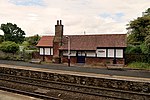Silverdale, Lancashire

Silverdale is a village and civil parish within the City of Lancaster district of Lancashire, England. The village stands on Morecambe Bay, near the border with Cumbria, 4.5 miles (7 km) north west of Carnforth and 8.5 miles (14 km) of Lancaster. The parish had a population of 1,519 recorded in the 2011 census. Silverdale forms part of the Arnside and Silverdale Area of Outstanding Natural Beauty. The RSPB's Leighton Moss nature reserve is close to the village train station. The National Trust owns several pieces of land in the area. The former Tarmac-owned Trowbarrow quarry is now a SSSI and popular climbing location. The Lancashire Coastal Way footpath goes from Silverdale to Freckleton, and the Cumbria Coastal Way goes from Silverdale to Gretna. It is served by nearby Silverdale railway station on the line from Lancaster to Barrow in Furness.
Excerpt from the Wikipedia article Silverdale, Lancashire (License: CC BY-SA 3.0, Authors, Images).Silverdale, Lancashire
Stankelt Road, Lancaster Silverdale
Geographical coordinates (GPS) Address Nearby Places Show on map
Geographical coordinates (GPS)
| Latitude | Longitude |
|---|---|
| N 54.167 ° | E -2.827 ° |
Address
Stankelt Road
Stankelt Road
LA5 0TW Lancaster, Silverdale
England, United Kingdom
Open on Google Maps











